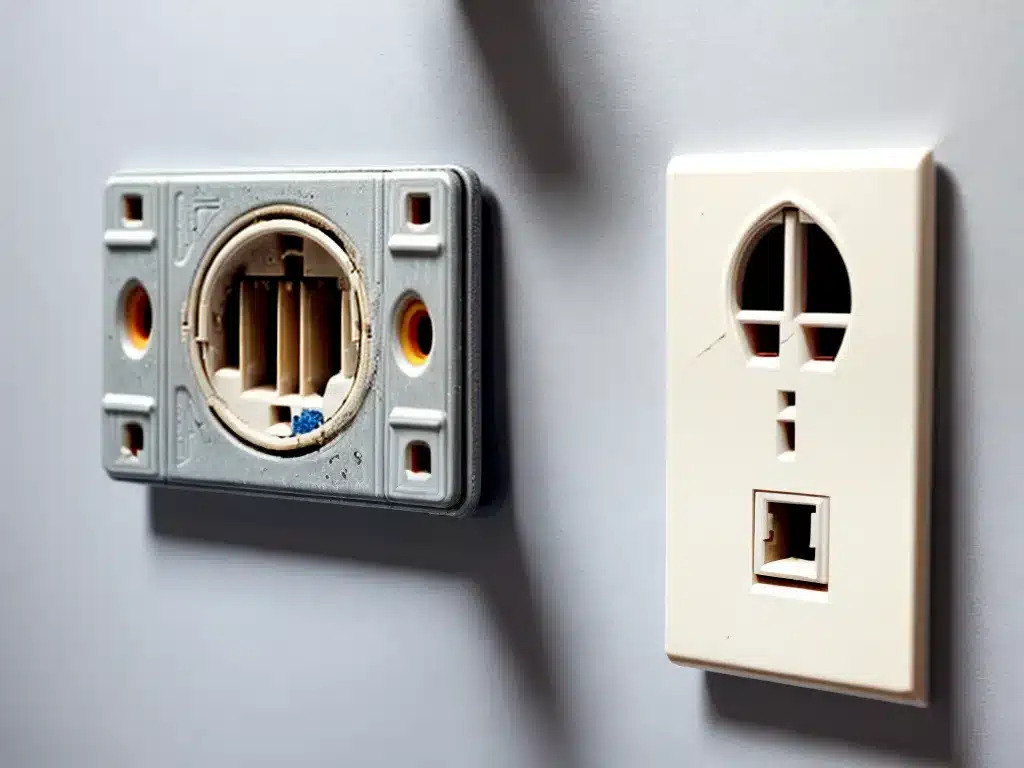 Outdated Electrical Sockets“” />
Outdated Electrical Sockets“” />
I have discovered that outdated electrical sockets can pose serious risks that many homeowners are unaware of. Replacing antique sockets with modern, up-to-code receptacles is crucial for safety. In this article, I will discuss the hidden dangers of outdated electrical sockets in depth.
Shock and Electrocution Risk
Outdated electrical sockets that lack a ground wire are extremely hazardous. Ungrounded two-prong receptacles were commonly installed in homes built before the 1960s. However, these old sockets provide no safe path to ground for electricity in the event of a fault or short circuit.
Without a ground wire, if something goes wrong with an electrical appliance or the home’s wiring, the metal parts can become energized. This leads to the serious risks of:
- Electric shock – Current flowing through the body can cause painful shocks.
- Electrocution – More severe shocks can lead to severe injury or death.
Children are especially vulnerable to electric shock from inserting objects into an ungrounded socket. Shock risks are hidden dangers that you cannot identify just by looking. Replacing ungrounded sockets with modern, three-prong, grounded receptacles greatly improves safety.
Fire Risk
Loose, corroded connections in outdated sockets are also fire hazards. Electricity arcing through loose contacts generates extreme heat that can ignite nearby flammable materials. Fires traced back to faulty electrical receptacles cause thousands of home fires every year.
In addition, undersized, outdated sockets may not grip plugs securely. Loose plug connections interrupt the flow of electricity, again causing dangerous arcing and heat.
Replacing worn, antique receptacles eliminates loose connections and reduces fire risks. Modern socket designs also have higher wattage ratings for handling today’s larger power demands safely.
Reliability Issues
Outdated electrical sockets are prone to intermittent power losses or flickering lights. This occurs when loose plug connections interrupt the flow of electricity. Faulty sockets are unable to maintain a consistent power supply.
Spotty power delivery is not just an annoyance. Voltage fluctuations can damage electronics like televisions, computers, and smart home devices. Replacing defective sockets restores reliable power flow throughout the home.
Difficulty Finding Replacement Plugs and Adapters
It can be tough finding replacement plugs and adapters compatible with obsolete socket designs. Two-prong plugs without a ground pin are practically extinct. Even finding three-prong adapters to add grounding may be impossible for some antique receptacles.
Lack of suitable plugs forces dangerous, improper substitutions. For example, using a three-prong plug with the ground pin broken off in a two-prong socket bypasses safety grounding. Upgrading wiring and sockets makes finding replacement plugs easy again.
Wasted Energy and Higher Bills
Poor connections in outdated electrical sockets also waste electricity. Heat generated by resistance across loose contacts gets dissipated as wasted energy instead of useful power.
The extra energy loss monthly from faulty receptacles leads to higher electricity bills. Replacing defective sockets conserves electricity and saves money every month.
Difficulty Finding Replacement Parts
Finding repair parts for obsolete electrical receptacles manufactured decades ago can be impossible. Circuit breakers, wiring, and other components degrade over time. Entirely replacing outdated sockets and wiring is often easier than hunting down obsolete repair parts.
Decreased Home Value
While outdated electrical systems may still function, home buyers in today’s market still view them as safety hazards that decrease property value. On the other hand, upgrading provides peace of mind for buyers and can increase resale value.
Steps to Upgrade Outdated Electrical Sockets
Replacing antique electrical sockets with modern, safer receptacles is a crucial upgrade for any home. Here are some tips on how to remove outdated sockets and install up-to-code replacements:
- Hire a licensed, insured electrician to ensure the job is done properly.
- Replace ungrounded two-prong outlets with grounded sockets that accept modern three-prong plugs.
- Use sockets with high amperage ratings to handle larger appliance loads.
- Make sure new receptacles fit your wall box openings and align with the screw holes.
- Connect the ground wire to ensure safe electricity flow.
- Carefully connect the hot and neutral wires using good, tight connections.
- Consider adding more outlets to reduce use of extension cords and power strips.
- Use GFCI outlets in kitchens, bathrooms and other high-risk areas.
Upgrading to modern electrical outlets is a smart investment that greatly improves home safety. The hidden dangers of outdated, antique sockets are too hazardous to ignore.
